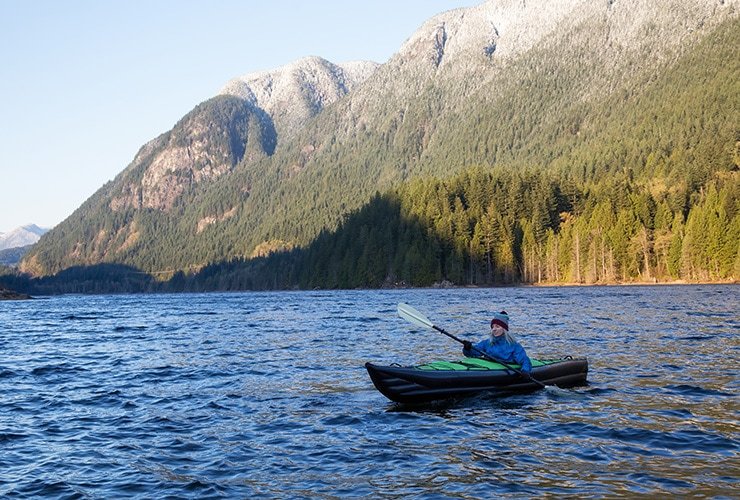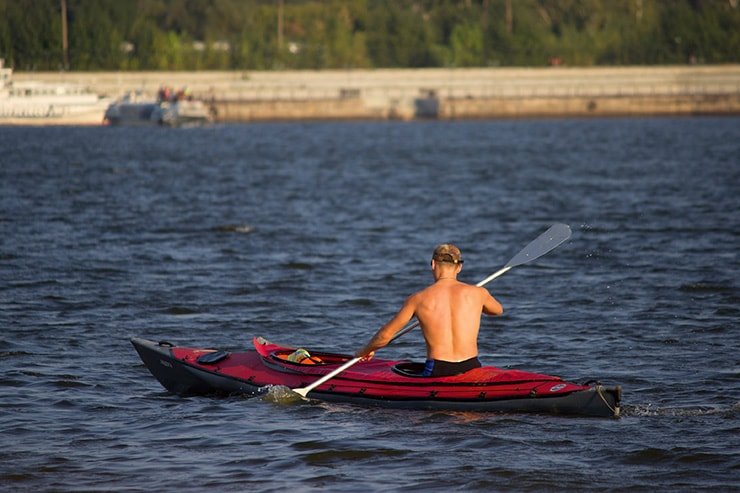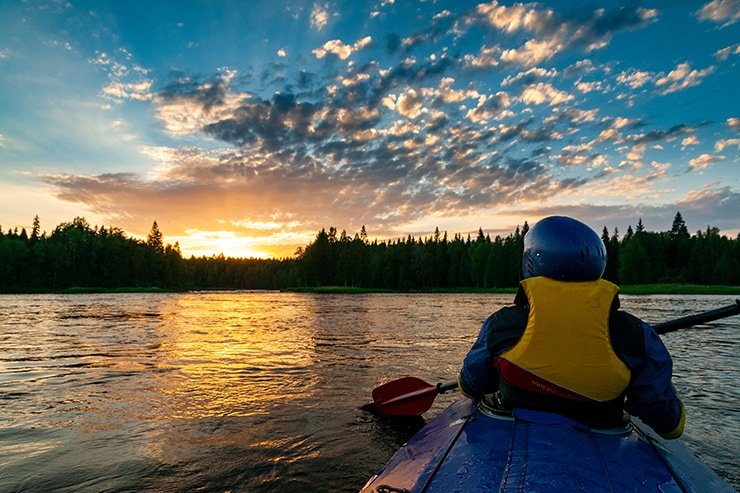Understanding and having a rough idea of the distance you can cover when kayaking can be very useful for trip planning, so, just how far can you kayak in a day?
A fairly experienced kayaker can comfortably kayak about 20 miles in a day and most regular kayakers can get to 20 miles and above. However, getting beyond this depends greatly on your personal endurance and how experienced you are.
There are some important factors to understand if you’re curious about long-distance kayaking.
Key Takeaways
- The distance you can kayak in a day depends on your experience, fitness, technique, kayak type, and water conditions.
- A fairly experienced kayaker can comfortably kayak about 20 miles in a day, but some elite athletes can cover over 100 miles in 24 hours.
- Kayaking long distances requires sport-specific endurance, which can be improved by practicing regularly and gradually increasing your distance and speed.
- You should also consider your general physical preparedness–strengthen your muscles, keep your heart healthy and fit, and do light aerobics.
A Kayaker Can Paddle 10 – 30 Miles A day, But That Distance Could Vary
Kayaking long distances is hard work, and some factors influence how far you can travel -it’s practically impossible to say what your maximum possible distance could be. It’s also important to clarify that a “day” of kayaking is not 24 hours; outside of extreme endurance sports athletes, nobody is kayaking for that long.
Most experienced kayakers will tell you not to kayak for more than 5 hours straight; fatigue sets in after that, affecting your decision-making abilities and technique. Plus, depending on the water conditions, it can compromise your safety.
So, anyone planning a long kayaking trip should take care not to think of it as an entire day, but rather the maximum time that you spend actually kayaking. The maximum might range up to 8 – 9 hours, but for a novice kayaker this would be incredibly ambitious.
Your Experience Level Can Affect How Far You Can Kayak
Your experience level can vastly affect your distance as it directly contributes to your paddling technique, paddling speed, endurance, and fitness.
A kayaker with thousands of hours on the water will have an efficient paddling technique, which means not only can they go faster, and therefore have greater kayak speed, they can do this while expending less energy.
This is called sport-specific endurance and there’s no shortcutting this. You can be physically fit, be an avid jogger and still not match an experienced kayaker.
Elite-level athletes can cover over 100 miles in 24 hours, but the average person might struggle to break 30. For an example of the kind of feats humans are capable of, Sebastian Szubski traveled approximately 156.41 miles in 24 hours!

Weather Conditions Can Limit How far You Can Kayak in a Day
It’s also important to factor in the weather, rain, heavy winds and rough waters will certainly affect how many miles you can cover overall. Kayaking in rougher water drains your energy faster, which may slow down your pace and reduce your distance.
However, while a strong wind to the face will hamper your efforts, a strong wind propelling you from the back can dramatically increase your speed. If you’re thinking about doing some long-distance paddling, it’s better to do so at a time when the winds are calmer..
If you’re planning to do any ocean kayaking over long distances that weather can dramatically alter water conditions, strong winds give rise to larger waves and more powerful currents – these currents can propel you forward but also make you feel like you are paddling through cement.
Overall, weather conditions can have a serious impact on how far you can kayak.
ALSO READ: How much wind is too much for kayaking?
The Type of Kayak You Use Will Affect How Far You Can Paddle
While it’s not as important as the factors above, the type of kayak you’re using can affect the amount of distance you can cover in a predetermined amount of time, and other attributes like kayak weight can also play a part.
A heavier kayak will have a slower average speed but greater stability. Greater stability can benefit you in more challenging waters, as it will allow you to maintain a more even pace, instead of slowing down.
The heavier weight becomes a disadvantage in calmer waters, as it doesn’t move through the water as efficiently as a lighter kayak.
It’s also important to think about comfort and ease of use. Sit-on-top and sit-inside kayaks are all great options for comfort over the long haul, and even an inflatable kayak can work well over longer distances.
A tandem kayak in the hands of experienced kayakers can also be an excellent option for long distances – these longer kayaks (as they’re built for two people) have a higher potential maximum speed and it’s easier for two paddlers to reach higher speeds.
How Fast Do Kayaks Actually Go?
There’s an equation you can use to calculate the max speed of your kayak. The formula is 1.34 multiplied by the square root of the hull’s waterline length, for a kayak with 9 feet of waterline length would look like this:
1.34 x 3 (square root of 9) = 4.02 (rounded down to 4 knots per her and converted to 4.5 MPH)
However, it’s very important to understand that while longer hulls have more maximum speed it’s also much more challenging to achieve that kayak’s theoretical maximum speed.
Another thing is that these numbers in an abstract don’t really tell us that much, an experienced kayaker may not reach anywhere near the max speed of their kayak in choppy weather conditions, or if they’re having a bad day because it does require significant effort to maintain close to maximum speeds over time.

So How Long Should it Take to Kayak for a Mile?
How long it takes to kayak a mile can depend on many things, such as the type of kayak, the water conditions and the kayaker’s experience. A veteran kayaker in a longer kayak may easily manage to go at a pace of a mile every 20 minutes. However, a recreational kayaker might reach a mile every 30 – 40 minutes.
A good range would be one mile every 25 – 30 minutes, but as mentioned this is going to vary wildly depending on the individual.
Do You Need To Be Fit to Kayak Long Distances?
You need to be fit, even if you’re kayaking for a few hours on flat water, it will impose demands on your body. You’ll need strong arms and a strong core to maintain a reasonably good pace.
Trying to get anywhere near your kayak’s theoretical maximum speed over long periods requires an elite level of fitness. It’s the equivalent of jogging at a decent pace for multiple hours, the average person isn’t going to be capable of that without training.
You don’t necessarily have to maintain a fast pace to kayak over long distances but you have to be in ok shape – it’s not the same as a recreational paddle for an hour. If you would struggle to do a brisk walk for several hours or a hike for a long period then kayaking will be no different.
How To Improve Your Kayaking Distance
If you want to improve your kayaking distance and you’re a newbie or a veteran who maybe hasn’t attempted longer periods of kayaking then there are a few simple things you can do to get better.
Practise
The more time you spend on the water, the better you’ll get at paddling. If you want to get better at any skill you have to put the hours in and kayaking is no exception. Putting the hours in doesn’t necessarily mean going on gargantuan trips, you can shorter distances more frequently and go from there.
You’ll need to break out of your comfort zone if you want to improve your distance but don’t force yourself to continue paddling when you’re exhausted. It’s much better to practice more frequently than to do a few long trips and potentially injure yourself.
Improve Fitness
Sports-specific endurance was something mentioned earlier and the only way to get it is to practice your sport – however, there’s another component of fitness called GPP, or general physical preparedness.
This is a concept that’s trickled down slowly but became very popular in modern-day fitness culture. Its training is targeted at improving the general capabilities of the body, strengthening your muscles, keeping your heart healthy and fit, etc.
This doesn’t mean going on gut-wrenching runs and lifting heavy weights, some simple strengthening exercises and light aerobics are all you need. Kayaking works many muscles, but targeted exercises can strengthen the muscles that support your posture and help make the most of your developing technique.

Don’t Chase Numbers
Trying to add distance and improve your speed week in and week out is a worthy goal, but obsessively chasing numbers can be counterproductive and lead to burnout. Distance is all about stamina and that doesn’t always develop according to schedule.
Taking your time and starting slow and improving gradually is the foolproof method for success. If you’re really trying to build up your distance and go for the longer 5-hour and up kayaking trips when you’re not used to it, you’re going to have to take time and be patient.
Join a Community
Joining a community of kayakers can be a great way to get advice and mentorship all for free. You’ll gain information about the local waterways that’s pretty much impossible to learn anywhere else, and perhaps most importantly, you’ll get motivation from your peers to stick to kayaking goals over the long term.
Conclusion
To answer the question “how far can you kayak in a day” depends on a lot of individual factors, but nearly anyone who wants to can build up to long distances if they choose to.
Your typical paddler can very easily manage 10 miles in a day, but higher mileage warrants more time and more speed that comes with experience.
We hope you’ve enjoyed reading this article and found the information useful, please comment or share with anyone who you think might be interested.

